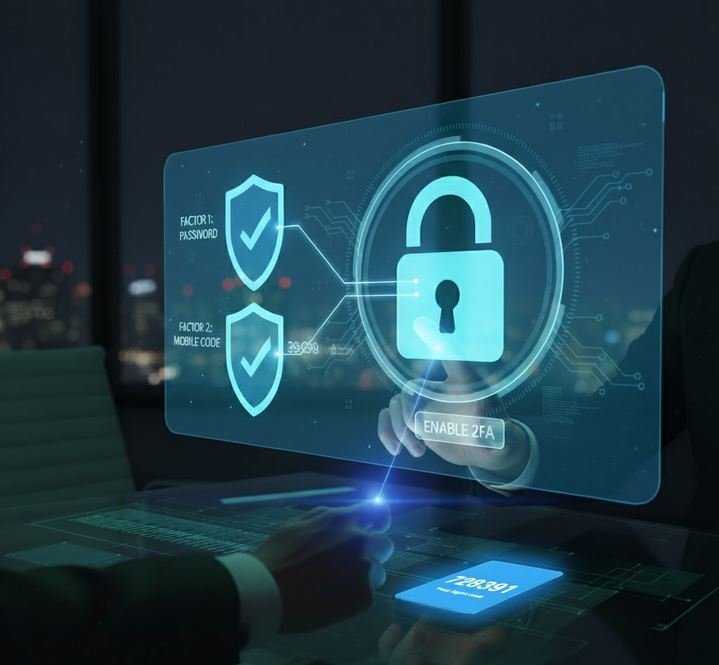
Your Digital Bouncer: Why You Need to Enable Two-Factor Authentication (2FA) Now
In an age where data breaches are common and passwords can be stolen or guessed, relying solely on a password to protect your online accounts is like locking your front door but leaving the key under the mat. Enter Two-Factor Authentication (2FA) – your digital bouncer that adds an essential second layer of security, making it exponentially harder for unauthorized users to access your accounts, even if they have your password.
What is Two-Factor Authentication (2FA)?
1. Something You Know: Your password (the first factor).
2. Something You Have: A physical item like your smartphone (for a code via SMS or an authenticator app), a hardware security key, or an email account.
3. Something You Are: A biometric (fingerprint, face scan).
When you enable 2FA, logging into an account will require your password plus a code sent to your phone, a tap on your security key, or a biometric scan. This means if a hacker steals your password, they still won't be able to get in because they don't have your second factor.
Why is 2FA Crucial? The "If Not When" Scenario
· Password Theft is Rampant: Passwords are stolen through phishing attacks, malware, and large-scale data breaches (where millions of passwords are leaked). Even if your password is strong, it could already be compromised without your knowledge.
· Brute-Force & Guessing Attacks: Automated programs can try thousands of password combinations per second.
· Weak Password Habits: Many people still use simple, reused, or easily guessable passwords.
· The "Second Lock" Principle: Imagine a thief has a copy of your house key. With 2FA, even if they have the key (your password), they still need to get past a second, unique lock (your second factor) that they don't have.
2FA significantly reduces the risk of unauthorized access, even if your password falls into the wrong hands. It transforms the "if" your account gets compromised into "almost impossible" for attackers without both factors.
Common Types of 2FA
· SMS Codes: A code is sent to your registered phone number. Convenient, but can be susceptible to "SIM swapping" attacks.
· Authenticator Apps (e.g., Google Authenticator, Authy): Generate time-sensitive codes directly on your smartphone. More secure than SMS as they don't rely on your phone number.
· Hardware Security Keys (e.g., YubiKey): Physical devices you plug into your computer or tap against your phone. Highly secure and phishing-resistant.
· Email Codes: A code sent to a backup email address. Less secure than authenticator apps or hardware keys if your email itself isn't secured with 2FA.
· Biometrics: Fingerprint or face scans (often used for phone unlocks, and increasingly for app logins).
How to Enable 2FA on Your Accounts
1. Email Accounts: Gmail, Outlook, Yahoo Mail (Your email is often the "recovery key" for other accounts, so secure it first!)
2. Social Media: Facebook, Twitter, Instagram, LinkedIn
3. Financial Accounts: Banks, investment platforms, payment services (PayPal, Venmo)
4. Online Shopping: Amazon, eBay, other major retailers
5. Cloud Storage: Google Drive, Dropbox, iCloud
6. Work Accounts: If your workplace provides 2FA, use it!
General Steps to Enable 2FA:
1. Log in to the account you want to protect.
2. Navigate to "Security Settings," "Privacy Settings," or "Login & Security."
3. Look for an option like "Two-Factor Authentication," "2-Step Verification," or "Multi-Factor Authentication (MFA)."
4. Follow the on-screen instructions, which usually involve verifying your identity and choosing your preferred 2FA method (e.g., linking an authenticator app, registering your phone number).
5. Important: Always save any backup codes provided. These are crucial if you lose access to your primary 2FA method (e.g., if you lose your phone).
Don't Wait – Protect Your Digital Life Today!
 Like
0
Like
0
 Dislike
0
Dislike
0
 Love
0
Love
0
 Funny
0
Funny
0
 Angry
0
Angry
0
 Sad
0
Sad
0
 Wow
0
Wow
0